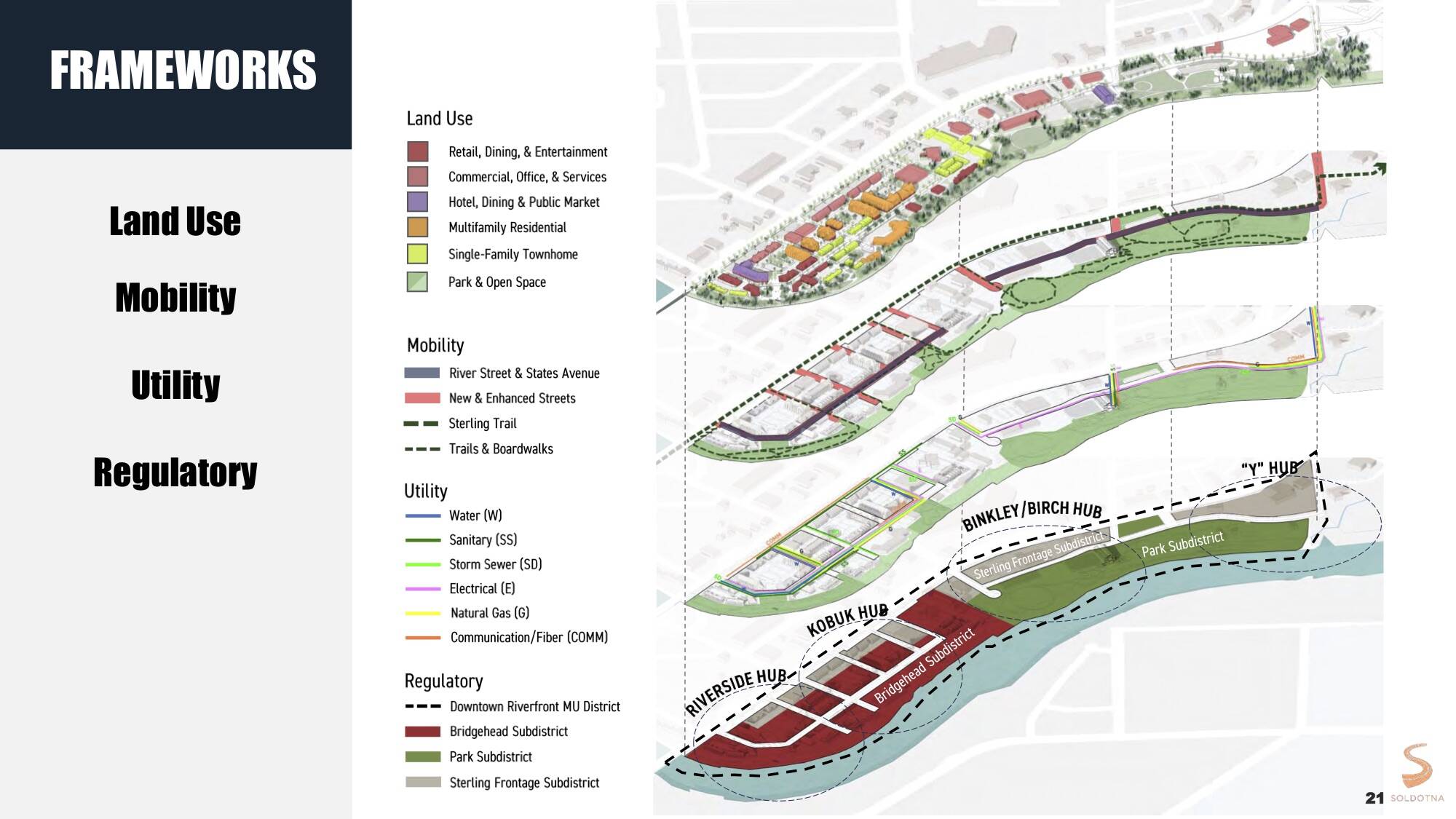The City of Soldotna is finalizing a comprehensive design plan for roughly 85 acres of land between the Sterling Highway and the Kenai River, also called the Soldotna Waterfront Redevelopment Project.
Members of the Soldotna City Council and Soldotna’s Planning and Zoning Commission convened in city hall on Nov. 14 to review the proposed master design plan during a joint work session. The group was joined by Project Manager Jason Graf, of firm First Forty Feet, and Cadence Petros, of firm ECONorthwest, who outlined a phased approach and associated estimated costs and impacts.
Last week’s work session came more than two years after the City of Soldotna first applied for a $360,000 grant from the U.S. Economic Development Agency to fund planning efforts for a revamped waterfront. The city was awarded the grant last summer and has since held interactive community events to gather public input on various proposals.
Trails, community gathering places and a community market space were key components of the design plans presented by project leads to council members and commissioners last week. The city council is expected to consider a master design plan during their next regular meeting on Dec. 13.
Four commerce “hubs” located throughout the project area each have their own development plan and unique attributes. For example, fixtures at the “Riverside Hub,” located near where the Sterling Highway crosses the Kenai River include new housing developments as well as retail and dining establishments.
Key elements of the development plan, which project leads said come from input they received from members of the public at community meetings, include public gathering spaces that “bookend” the project area, a riverfront trail, a public market and the extension of existing pathways to the Kenai River.
A prominent feature of the new design plans is a 32,000-square-foot market hall. A schematic design of the market hall shows a three-story building on the western end of Soldotna Creek Park that is connected to a two-level parking structure.
The main level of the market hall would house vendor stalls and a central commons, while the lower level would house “anchor tenants,” or businesses that need more space than a stall can accommodate. The upper level would house meeting and community rooms.
The plan also outlines three trails that would be central to the redevelopment, including an extension of Soldotna Creek Park’s existing boardwalk and riverfront trails. A separate “Sterling Trail” would parallel the Sterling Highway and be separated from traffic by landscape buffers. A third multi-use trail would connect different parts of the redevelopment project area.
Council members have generally been supportive of the redevelopment of Soldotna’s waterfront, but were encouraged to voice their remaining thoughts or concerns to project and city staff during the work session. The city has said it plans to bring back the final planning document for the body to review and adopt in December.
Council member Dan Nelson questioned whether the level of planning and financial support the project scope would require is a feasible lift for the city’s staff.
“Through no fault of your own, you’re tremendously underselling the time and monetary and kind of in-kind effort that it takes to do (the) grant applications to do some of this,” Nelson said.
City council member Jordan Chilson questioned the inclusion of single-family townhomes along the Kenai River, which he said would likely be expensive and produce “extreme gentrification.”
“If we’re building single-family homes on the river, those are going to be million dollar homes,” he said. “How does that do anything to address affordable housing in our community? It just prices people out of them and it just takes away from other economic development opportunities … in that area.”
Discussions of redevelopment along the Kenai River in Soldotna have coincided with the planned evictions of residents at River Terrace RV Park. That park is home to more than a dozen year-round residents and sits inside what project developers envision as a “Riverside Hub.”
Both the City of Soldotna and attorney Jim Butler — who represents the owners of the River Terrace property — have said that redevelopment and the planned evictions of River Terrace residents are unrelated. Rather, Butler said that the owners have long been looking to scale back operations on the property and have not been singled out from other property owners in the area.
City council members during their Nov. 14 work session heard from one remote attendee who did not identify herself, but said she is a resident at the River Terrace RV Park. She said the planned evictions mean she will have to find a new place to live by May 4, and asked if the city has a plan for the park’s low-income residents, who live in the project area.
“Not at this time,” Mayor Paul Whitney told her. “That’s private ownership and that’s up to the property owners.”
Soldotna City Council members will next convene on Dec. 13. The Nov. 14 work session can be streamed on the City of Soldotna’s YouTube channel. More information about the Soldotna Riverfront Redevelopment Project can be found on the project site at soldotnariverfront.org.
Reach reporter Ashlyn O’Hara at ashlyn.ohara@peninsulaclarion.com.

